engine MERCEDES-BENZ G-CLASS SUV 2008 Owners Manual
[x] Cancel search | Manufacturer: MERCEDES-BENZ, Model Year: 2008, Model line: G-CLASS SUV, Model: MERCEDES-BENZ G-CLASS SUV 2008Pages: 293, PDF Size: 4.49 MB
Page 8 of 293
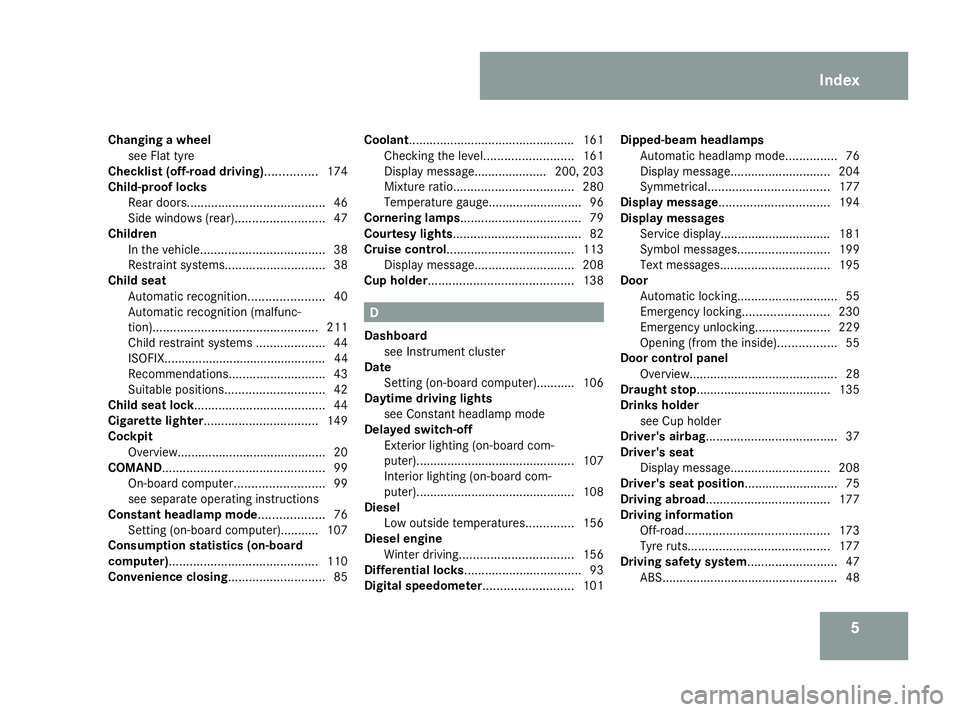
5
Changing a wheel
see Flat tyre
Checklist (off-road driving)............... 174
Child-proof locks Rear doors. ....................................... 46
Side windows (rear) ..........................47
Children
In the vehicle. ................................... 38
Restraint systems. ............................ 38
Child seat
Automatic recognition ......................40
Automatic recognition (malfunc-
tion). ............................................... 211
Child restraint systems ....................44
ISOFIX............................................... 44
Recommendations. ...........................43
Suitable positions. ............................ 42
Child seat lock...................................... 44
Cigarette lighter................................. 149
Cockpit Overview. .......................................... 20
COMAND............................................... 99
On-board computer. .........................99
see separate operating instructions
Constant headlamp mode................... 76
Setting (on-board computer).......... .107
Consumption statistics (on-board
computer)........................................... 110
Convenience closing............................ 85Coolant................................................
161
Checking the level. .........................161
Display message..................... 200, 203
Mixture ratio ................................... 280
Temperature gauge ...........................96
Cornering lamps................................... 79
Courtesy lights..................................... 82
Cruise control..................................... 113
Display message ............................. 208
Cup holder.......................................... 138 D
Dashboard see Instrument cluster
Date
Setting (on-board computer).......... .106
Daytime driving lights
see Constant headlamp mode
Delayed switch-off
Exterior lighting (on-board com-
puter). ............................................. 107
Interior lighting (on-board com-
puter). ............................................. 108
Diesel
Low outside temperatures. .............156
Diesel engine
Winter driving. ................................ 156
Differential locks.................................. 93
Digital speedometer.......................... 101Dipped-beam headlamps
Automatic headlamp mode. ..............76
Display message ............................. 204
Symmetrical. .................................. 177
Display message ................................ 194
Display messages Service display................................ 181
Symbol messages. ..........................199
Text messages. ............................... 195
Door
Automatic locking ............................. 55
Emergency locking .........................230
Emergency unlocking...................... 229
Opening (from the inside). ................55
Door control panel
Overview. .......................................... 28
Draught stop....................................... 135
Drinks holder
see Cup holder
Driver's airbag...................................... 37
Driver's seat Display message ............................. 208
Driver's seat position........................... 75
Driving abroad.................................... 177
Driving information Off-road .......................................... 173
Tyre ruts. ........................................ 177
Driving safety system.......................... 47
ABS. .................................................. 48 Index
463_AKB; 1; 8, en-GB
wobuchh,
Version: 2.10.6 2008-07-17T15:19:41+02:00 - Seite 5Dateiname: 6515_4091_02_buchblock.pdf; preflight
Page 9 of 293
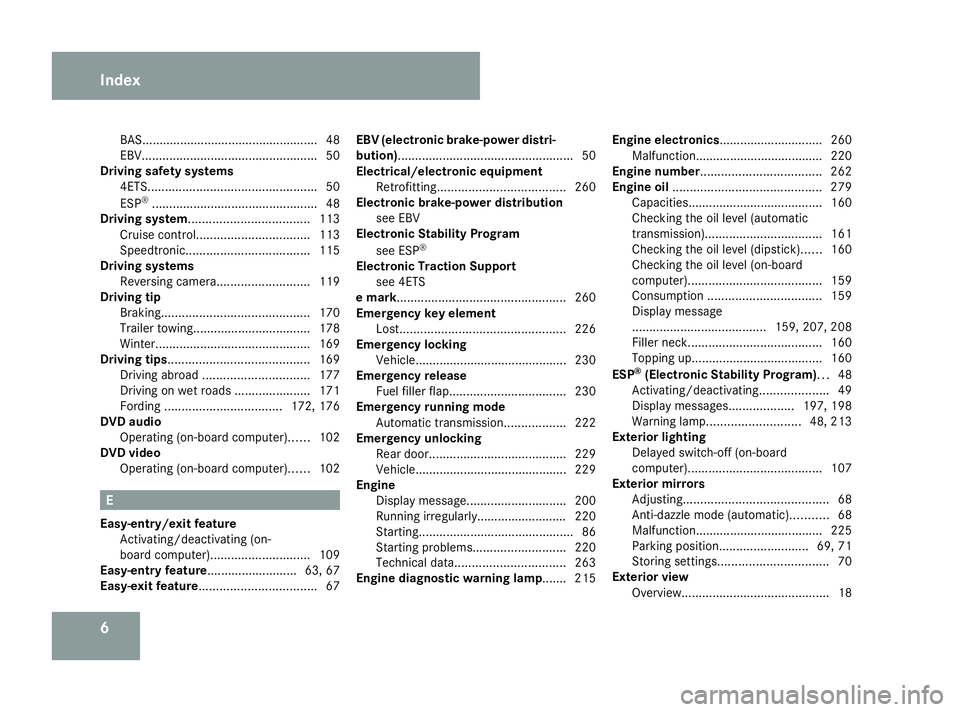
6BAS.
.................................................. 48
EBV. .................................................. 50
Driving safety systems
4ETS. ................................................ 50
ESP ®
................................................ 48
Driving system................................... 113
Cruise control. ................................ 113
Speedtronic. ................................... 115
Driving systems
Reversing camera. ..........................119
Driving tip
Braking ........................................... 170
Trailer towing. ................................. 178
Winter ............................................. 169
Driving tips......................................... 169
Driving abroad ............................... 177
Driving on wet roads ......................171
Fording .................................. 172, 176
DVD audio
Operating (on-board computer). .....102
DVD video
Operating (on-board computer). .....102 E
Easy-entry/exit feature Activating/deactivating (on-
board computer). ............................ 109
Easy-entry feature ..........................63, 67
Easy-exit feature.................................. 67EBV (electronic brake-power distri-
bution)
................................................... 50
Electrical/electronic equipment Retrofitting ..................................... 260
Electronic brake-power distribution
see EBV
Electronic Stability Program
see ESP ®
Electronic Traction Support see 4ETS
e mark................................................. 260
Emergency key element Lost. ............................................... 226
Emergency locking
Vehicle............................................ 230
Emergency release
Fuel filler fla p.................................. 230
Emergency running mode
Automatic transmission ..................222
Emergency unlocking
Rear door. ....................................... 229
Vehicle............................................ 229
Engine
Display message ............................. 200
Running irregularl y.......................... 220
Starting ............................................. 86
Starting problems ........................... 220
Technical data. ............................... 263
Engine diagnostic warning lamp....... 215 Engine electronics.............................. 260
Malfunction..................................... 220
Engine number................................... 262
Engine oil ........................................... 279
Capacities.. ..................................... 160
Checking the oil level (automatic
transmission) .................................. 161
Checking the oil level (dipstick). .....160
Checking the oil level (on-board
computer). ...................................... 159
Consumption ................................. 159
Display message
....................................... 159, 207, 208
Filler neck. ...................................... 160
Topping up. ..................................... 160
ESP ®
(Electronic Stability Program)... 48
Activating/deactivating ....................49
Display messages ...................197, 198
Warning lamp. .......................... 48, 213
Exterior lighting
Delayed switch-off (on-board
computer). ...................................... 107
Exterior mirrors
Adjusting .......................................... 68
Anti-dazzle mode (automatic). ..........68
Malfunction..................................... 225
Parking position. ......................... 69, 71
Storing settings ................................ 70
Exterior view
Overview. .......................................... 18Index
463_AKB; 1; 8, en-GB
wobuchh,
Version: 2.10.6 2008-07-17T15:19:41+02:00 - Seite 6Dateiname: 6515_4091_02_buchblock.pdf; preflight
Page 11 of 293
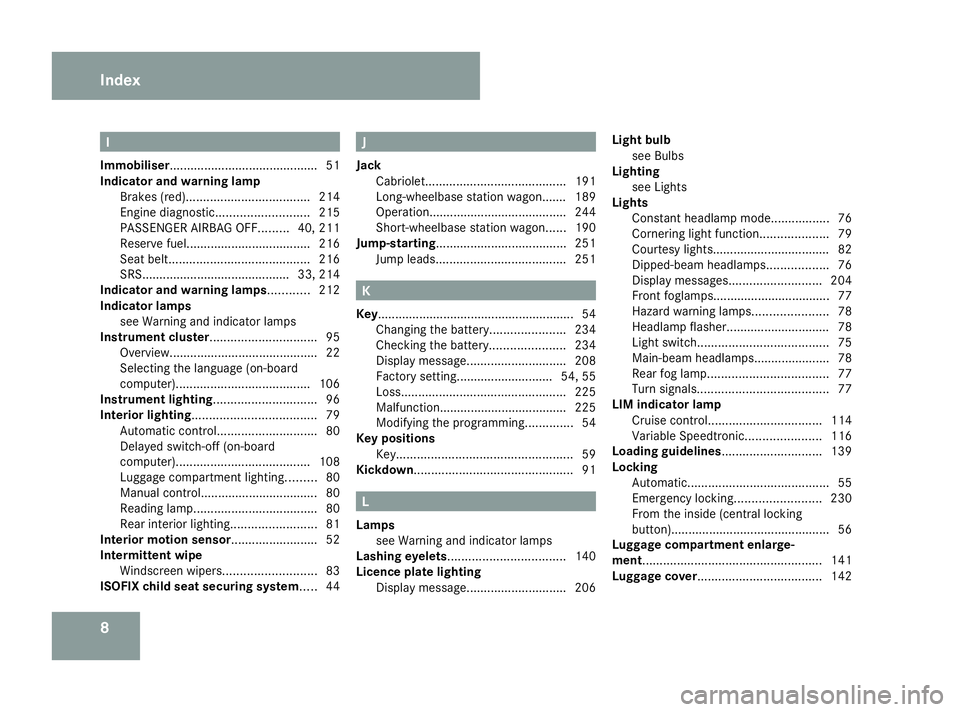
8 I
Immobiliser.......................................... .51
Indicator and warning lamp Brakes (red). ................................... 214
Engine diagnostic ........................... 215
PASSENGER AIRBAG OFF .........40, 211
Reserve fuel. ................................... 216
Seat belt. ........................................ 216
SRS........................................... 33, 214
Indicator and warning lamps............ 212
Indicator lamps see Warning and indicator lamps
Instrument cluster............................... 95
Overview. .......................................... 22
Selecting the language (on-board
computer). ...................................... 106
Instrument lighting.............................. 96
Interior lighting.................................... 79
Automatic control ............................. 80
Delayed switch-off (on-board
computer). ...................................... 108
Luggage compartment lighting. ........80
Manual control.................................. 80
Reading lamp .................................... 80
Rear interior lighting. ........................81
Interior motion sensor......................... 52
Intermittent wipe Windscreen wipers. ..........................83
ISOFIX child seat securing system..... 44 J
Jack Cabriolet. ........................................ 191
Long-wheelbase station wagon....... 189
Operation........................................ 244
Short-wheelbase station wagon. .....190
Jump-starting ...................................... 251
Jump leads ...................................... 251 K
Key......................................................... 54 Changing the battery ......................234
Checking the battery ......................234
Display message ............................. 208
Factory setting............................ 54, 55
Loss. ............................................... 225
Malfunction..................................... 225
Modifying the programming. .............54
Key positions
Key. .................................................. 59
Kickdown.............................................. 91 L
Lamps see Warning and indicator lamps
Lashing eyelets.................................. 140
Licence plate lighting Display message ............................. 206Light bulb
see Bulbs
Lighting
see Lights
Lights
Constant headlamp mode. ................76
Cornering light function ....................79
Courtesy lights.................................. 82
Dipped-beam headlamps ..................76
Display messages ........................... 204
Front foglamps.................................. 77
Hazard warning lamps. .....................78
Headlamp flasher.............................. 78
Light switch. ..................................... 75
Main-beam headlamps..................... .78
Rear fog lamp ................................... 77
Turn signals. ..................................... 77
LIM indicator lamp
Cruise control. ................................ 114
Variable Speedtronic. .....................116
Loading guidelines............................. 139
Locking Automatic. ........................................ 55
Emergency locking .........................230
From the inside (central locking
button) .............................................. 56
Luggage compartment enlarge-
ment.................................................... 141
Luggage cover.................................... 142Index
463_AKB; 1; 8, en-GB
wobuchh,
Version: 2.10.6 2008-07-17T15:19:41+02:00 - Seite 8Dateiname: 6515_4091_02_buchblock.pdf; preflight
Page 15 of 293
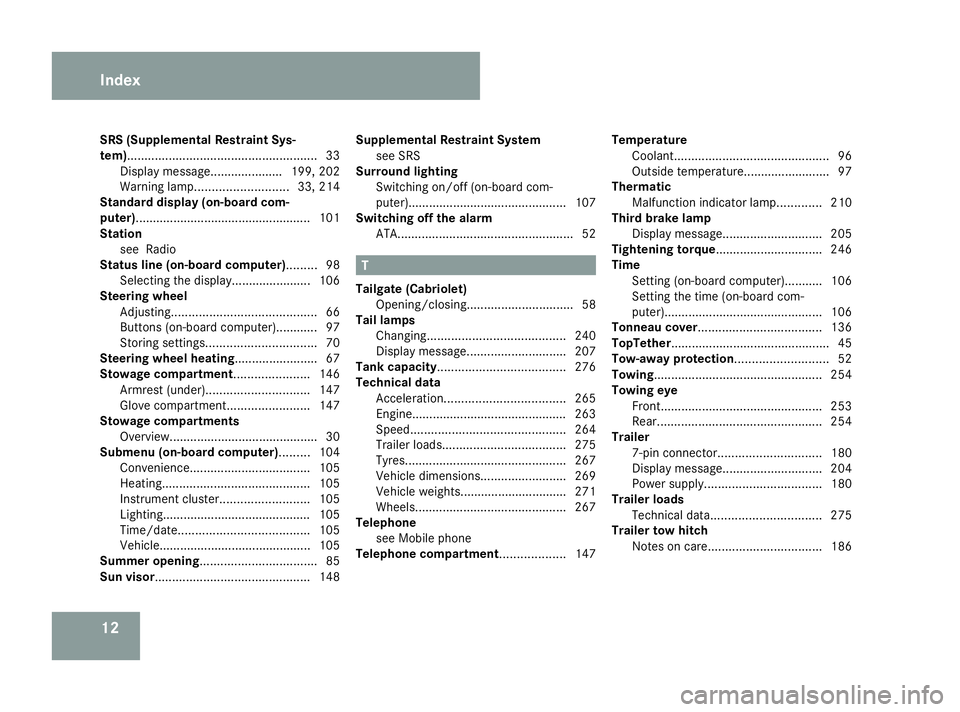
12
SRS (Supplemental Restraint Sys-
tem).......................................................
33
Display message..................... 199, 202
Warning lamp. .......................... 33, 214
Standard display (on-board com-
puter) ................................................... 101
Station see Radio
Status line (on-board computer)......... 98
Selecting the display....................... 106
Steering wheel
Adjusting .......................................... 66
Buttons (on-board computer)............ 97
Storing settings ................................ 70
Steering wheel heating........................ 67
Stowage compartment...................... 146
Armrest (under) .............................. 147
Glove compartment. .......................147
Stowage compartments
Overview. .......................................... 30
Submenu (on-board computer)......... 104
Convenience ................................... 105
Heating. .......................................... 105
Instrument cluster .......................... 105
Lighting........................................... 105
Time/date. ..................................... 105
Vehicle............................................ 105
Summer opening .................................. 85
Sun visor............................................. 148Supplemental Restraint System
see SRS
Surround lighting
Switching on/off (on-board com-
puter). ............................................. 107
Switching off the alarm
ATA. .................................................. 52 T
Tailgate (Cabriolet) Opening/closing. .............................. 58
Tail lamps
Changing. ....................................... 240
Display message ............................. 207
Tank capacity..................................... 276
Technical data Acceleration. .................................. 265
Engine............................................ .263
Speed. ............................................ 264
Trailer loads .................................... 275
Tyres. .............................................. 267
Vehicle dimensions. ........................269
Vehicle weights............................... 271
Wheels. ........................................... 267
Telephone
see Mobile phone
Telephone compartment................... 147Temperature
Coolant. ............................................ 96
Outside temperature......................... 97
Thermatic
Malfunction indicator lamp. ............210
Third brake lamp
Display message ............................. 205
Tightening torque............................... 246
Time Setting (on-board computer).......... .106
Setting the time (on-board com-
puter). ............................................. 106
Tonneau cover.................................... 136
TopTether.............................................. 45
Tow-away protection........................... 52
Towing................................................. 254
Towing eye Front. .............................................. 253
Rear. ............................................... 254
Trailer
7-pin connector .............................. 180
Display message ............................. 204
Power supply. ................................. 180
Trailer loads
Technical data. ............................... 275
Trailer tow hitch
Notes on care ................................. 186Index
463_AKB; 1; 8, en-GB
wobuchh,
Version: 2.10.6 2008-07-17T15:19:41+02:00 - Seite 12Dateiname: 6515_4091_02_buchblock.pdf; preflight
Page 18 of 293
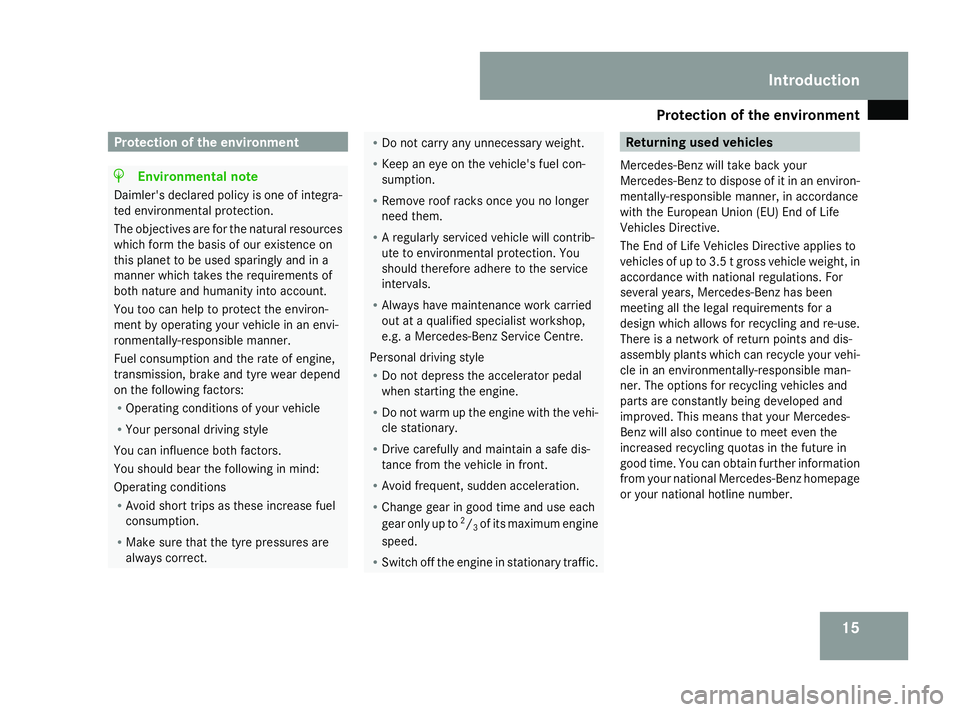
Protection of the environment
15Protection of the environment
H
Environmental note
Daimler's declared policy is one of integra-
ted environmental protection.
The objectives are for the natural resources
which form the basis of our existence on
this planet to be used sparingly and in a
manner which takes the requirements of
both nature and humanity into account.
You too can help to protect the environ-
ment by operating your vehicle in an envi-
ronmentally-responsible manner.
Fuel consumption and the rate of engine,
transmission, brake and tyre wear depend
on the following factors:
R Operating conditions of your vehicle
R Your personal driving style
You can influence both factors.
You should bear the following in mind:
Operating conditions
R Avoid short trips as these increase fuel
consumption.
R Make sure that the tyre pressures are
always correct. R
Do not carry any unnecessary weight.
R Keep an eye on the vehicle's fuel con-
sumption.
R Remove roof racks once you no longer
need them.
R A regularly serviced vehicle will contrib-
ute to environmental protection. You
should therefore adhere to the service
intervals.
R Always have maintenance work carried
out at a qualified specialist workshop,
e.g. a Mercedes-Benz Service Centre.
Personal driving style
R Do not depress the accelerator pedal
when starting the engine.
R Do not warm up the engine with the vehi-
cle stationary.
R Drive carefully and maintain a safe dis-
tance from the vehicle in front.
R Avoid frequent, sudden acceleration.
R Change gear in good time and use each
gear only up to 2
/ 3of its maximum engine
speed.
R Switch off the engine in stationary traffic. Returning used vehicles
Mercedes-Benz will take back your
Mercedes-Benz to dispose of it in an environ-
mentally-responsible manner, in accordance
with the European Union (EU) End of Life
Vehicles Directive.
The End of Life Vehicles Directive applies to
vehicles of up to 3.5 t gross vehicle weight, in
accordance with national regulations. For
several years, Mercedes-Benz has been
meeting all the legal requirements for a
design which allows for recycling and re-use.
There is a network of return points and dis-
assembly plants which can recycle your vehi-
cle in an environmentally-responsible man-
ner. The options for recycling vehicles and
parts are constantly being developed and
improved. This means that your Mercedes-
Benz will also continue to meet even the
increased recycling quotas in the future in
good time. You can obtain further information
from your national Mercedes-Benz homepage
or your national hotline number. Introduction
463_AKB; 1; 8, en-GB
wobuchh,
Version: 2.10.6 2008-07-17T15:19:41+02:00 - Seite 15 ZDateiname: 6515_4091_02_buchblock.pdf; preflight
Page 19 of 293
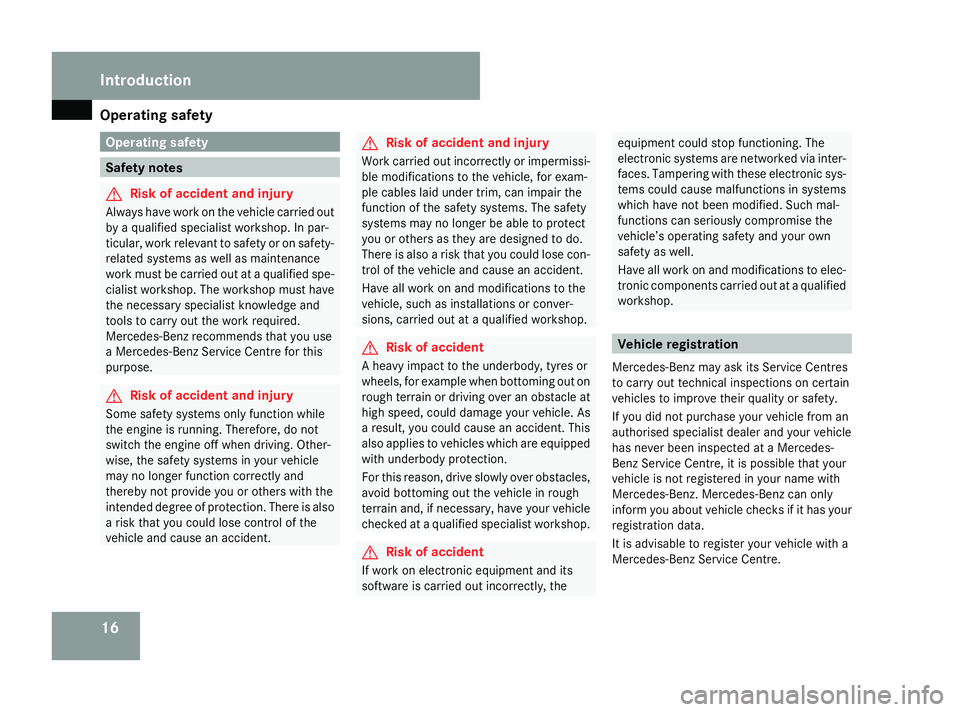
Operating safety
16 Operating safety
Safety notes
G
Risk of accident and injury
Always have work on the vehicle carried out
by a qualified specialist workshop. In par-
ticular, work relevant to safety or on safety-
related systems as well as maintenance
work must be carried out at a qualified spe-
cialist workshop. The workshop must have
the necessary specialist knowledge and
tools to carry out the work required.
Mercedes-Benz recommends that you use
a Mercedes-Benz Service Centre for this
purpose. G
Risk of accident and injury
Some safety systems only function while
the engine is running. Therefore, do not
switch the engine off when driving. Other-
wise, the safety systems in your vehicle
may no longer function correctly and
thereby not provide you or others with the
intended degree of protection. There is also
a risk that you could lose control of the
vehicle and cause an accident. G
Risk of accident and injury
Work carried out incorrectly or impermissi-
ble modifications to the vehicle, for exam-
ple cables laid under trim, can impair the
function of the safety systems. The safety
systems may no longer be able to protect
you or others as they are designed to do.
There is also a risk that you could lose con-
trol of the vehicle and cause an accident.
Have all work on and modifications to the
vehicle, such as installations or conver-
sions, carried out at a qualified workshop. G
Risk of accident
A heavy impact to the underbody, tyres or
wheels, for example when bottoming out on
rough terrain or driving over an obstacle at
high speed, could damage your vehicle. As
a result, you could cause an accident. This
also applies to vehicles which are equipped
with underbody protection.
For this reason, drive slowly over obstacles,
avoid bottoming out the vehicle in rough
terrain and, if necessary, have your vehicle
checked at a qualified specialist workshop. G
Risk of accident
If work on electronic equipment and its
software is carried out incorrectly, the equipment could stop functioning. The
electronic systems are networked via inter-
faces. Tampering with these electronic sys-
tems could cause malfunctions in systems
which have not been modified. Such mal-
functions can seriously compromise the
vehicle’s operating safety and your own
safety as well.
Have all work on and modifications to elec-
tronic components carried out at a qualified
workshop. Vehicle registration
Mercedes-Benz may ask its Service Centres
to carry out technical inspections on certain
vehicles to improve their quality or safety.
If you did not purchase your vehicle from an
authorised specialist dealer and your vehicle
has never been inspected at a Mercedes-
Benz Service Centre, it is possible that your
vehicle is not registered in your name with
Mercedes-Benz. Mercedes-Benz can only
inform you about vehicle checks if it has your
registration data.
It is advisable to register your vehicle with a
Mercedes-Benz Service Centre. Introduction
463_AKB; 1; 8, en-GB
wobuchh,
Version: 2.10.6 2008-07-17T15:19:41+02:00 - Seite 16Dateiname: 6515_4091_02_buchblock.pdf; preflight
Page 22 of 293
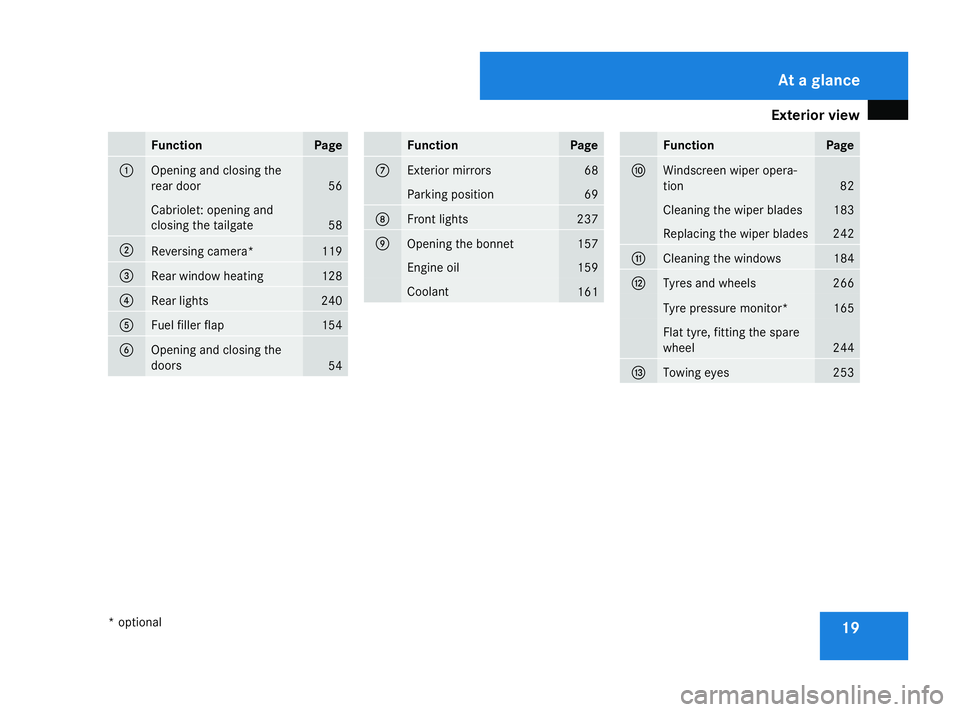
Exterior view
19Function Page
1
Opening and closing the
rear door 56
Cabriolet: opening and
closing the tailgate
58
2
Reversing camera* 119
3
Rear window heating 128
4
Rear lights 240
5
Fuel filler flap 154
6
Opening and closing the
doors 54 Function Page
7
Exterior mirrors 68
Parking position 69
8
Front lights 237
9
Opening the bonnet 157
Engine oil 159
Coolant
161 Function Page
a
Windscreen wiper opera-
tion
82
Cleaning the wiper blades 183
Replacing the wiper blades 242
b
Cleaning the windows 184
c
Tyres and wheels 266
Tyre pressure monitor* 165
Flat tyre, fitting the spare
wheel
244
d
Towing eyes 253At a glance
* optional
463_AKB; 1; 8, en-GB
wobuchh,
Version: 2.10.6 2008-07-17T15:19:41+02:00 - Seite 19Dateiname: 6515_4091_02_buchblock.pdf; preflight
Page 26 of 293
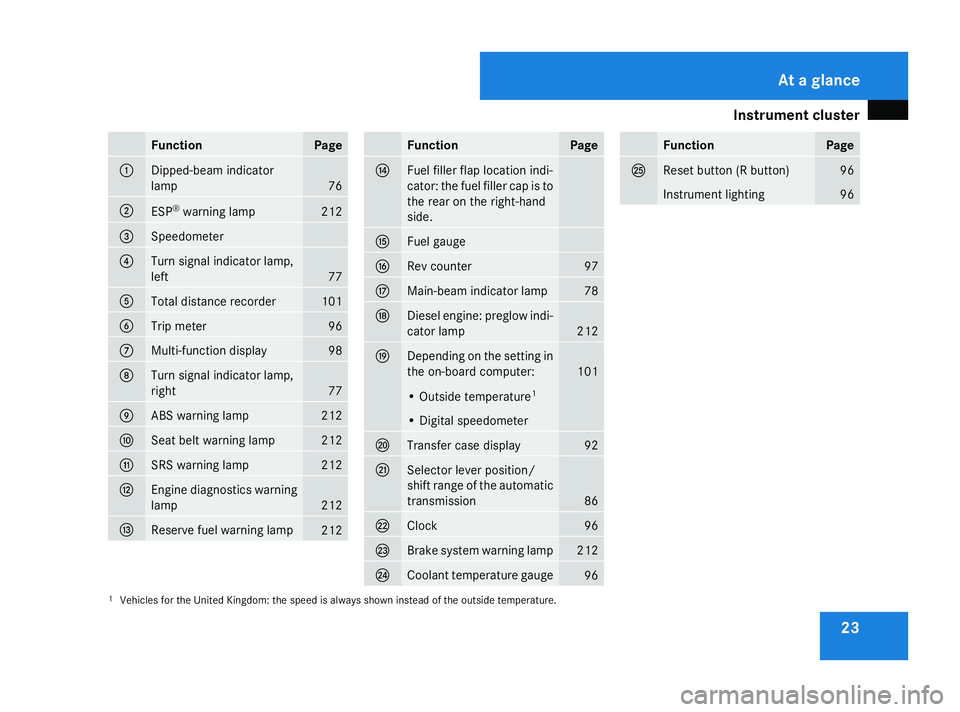
Instrument cluster
23Function Page
1
Dipped-beam indicator
lamp
76
2
ESP
®
warning lamp 212
3
Speedometer
4
Turn signal indicator lamp,
left 77
5
Total distance recorder 101
6
Trip meter 96
7
Multi-function display 98
8
Turn signal indicator lamp,
right 77
9
ABS warning lamp 212
a
Seat belt warning lamp 212
b
SRS warning lamp 212
c
Engine diagnostics warning
lamp
212
d
Reserve fuel warning lamp
212 Function Page
e
Fuel filler flap location indi-
cator: the fuel filler cap is to
the rear on the right-hand
side. f
Fuel gauge
g
Rev counter 97
h
Main-beam indicator lamp 78
j
Diesel engine: preglow indi-
cator lamp
212
k
Depending on the setting in
the on-board computer:
101
• Outside temperature
1 • Digital speedometer
l
Transfer case display 92
m
Selector lever position/
shift range of the automatic
transmission
86
n
Clock 96
o
Brake system warning lamp 212
p
Coolant temperature gauge
96 Function Page
q
Reset button (R button) 96
Instrument lighting 96
1 Vehicles for the United Kingdom: the speed is always shown instead of the outside temperature. At a glance
463_AKB; 1; 8, en-GB
wobuchh,
Version: 2.10.6 2008-07-17T15:19:41+02:00 - Seite 23Dateiname: 6515_4091_02_buchblock.pdf; preflight
Page 36 of 293
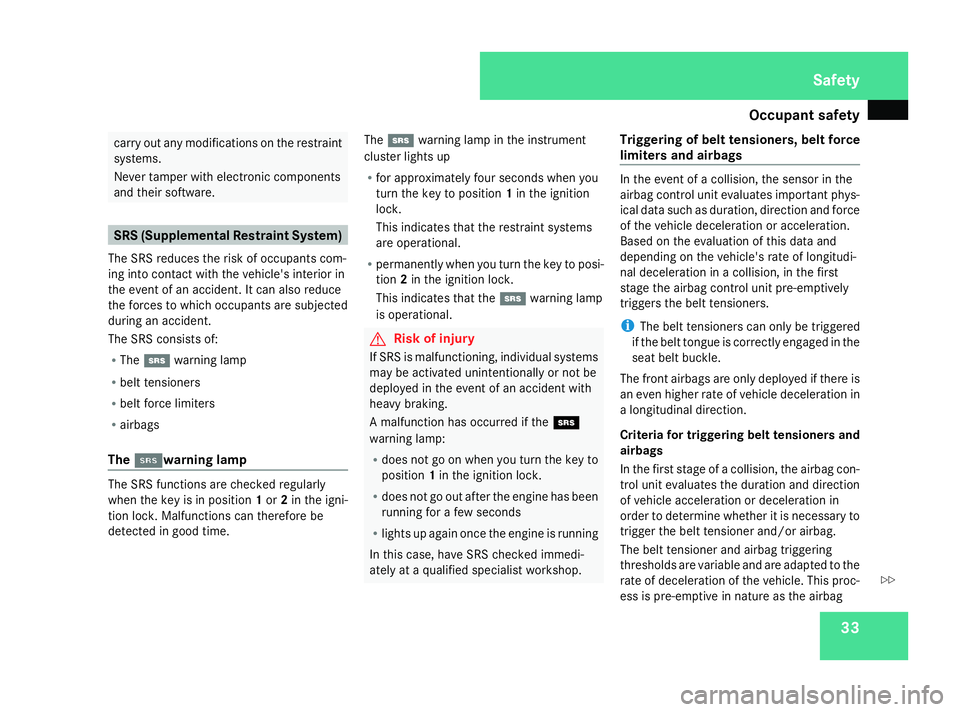
Occupant safety
33carry out any modifications on the restraint
systems.
Never tamper with electronic components
and their software.
SRS (Supplemental Restraint System)
The SRS reduces the risk of occupants com-
ing into contact with the vehicle's interior in
the event of an accident. It can also reduce
the forces to which occupants are subjected
during an accident.
The SRS consists of:
R The 1 warning lamp
R belt tensioners
R belt force limiters
R airbags
The 1 1warning lamp The SRS functions are checked regularly
when the key is in position
1or 2in the igni-
tion lock. Malfunctions can therefore be
detected in good time. The
1 warning lamp in the instrument
cluster lights up
R for approximately four seconds when you
turn the key to position 1in the ignition
lock.
This indicates that the restraint systems
are operational.
R permanently when you turn the key to posi-
tion 2in the ignition lock.
This indicates that the 1warning lamp
is operational. G
Risk of injury
If SRS is malfunctioning, individual systems
may be activated unintentionally or not be
deployed in the event of an accident with
heavy braking.
A malfunction has occurred if the 1
warning lamp:
R does not go on when you turn the key to
position 1in the ignition lock.
R does not go out after the engine has been
running for a few seconds
R lights up again once the engine is running
In this case, have SRS checked immedi-
ately at a qualified specialist workshop. Triggering of belt tensioners, belt force
limiters and airbags In the event of a collision, the sensor in the
airbag control unit evaluates important phys-
ical data such as duration, direction and force
of the vehicle deceleration or acceleration.
Based on the evaluation of this data and
depending on the vehicle's rate of longitudi-
nal deceleration in a collision, in the first
stage the airbag control unit pre-emptively
triggers the belt tensioners.
i The belt tensioners can only be triggered
if the belt tongue is correctly engaged in the
seat belt buckle.
The front airbags are only deployed if there is
an even higher rate of vehicle deceleration in
a longitudinal direction.
Criteria for triggering belt tensioners and
airbags
In the first stage of a collision, the airbag con-
trol unit evaluates the duration and direction
of vehicle acceleration or deceleration in
order to determine whether it is necessary to
trigger the belt tensioner and/or airbag.
The belt tensioner and airbag triggering
thresholds are variable and are adapted to the
rate of deceleration of the vehicle. This proc-
ess is pre-emptive in nature as the airbag Safety
463_AKB; 1; 8, en-GB
wobuchh,
Version: 2.10.6 2008-07-17T15:19:41+02:00 - Seite 33 ZDateiname: 6515_4091_02_buchblock.pdf; preflight
Page 38 of 293
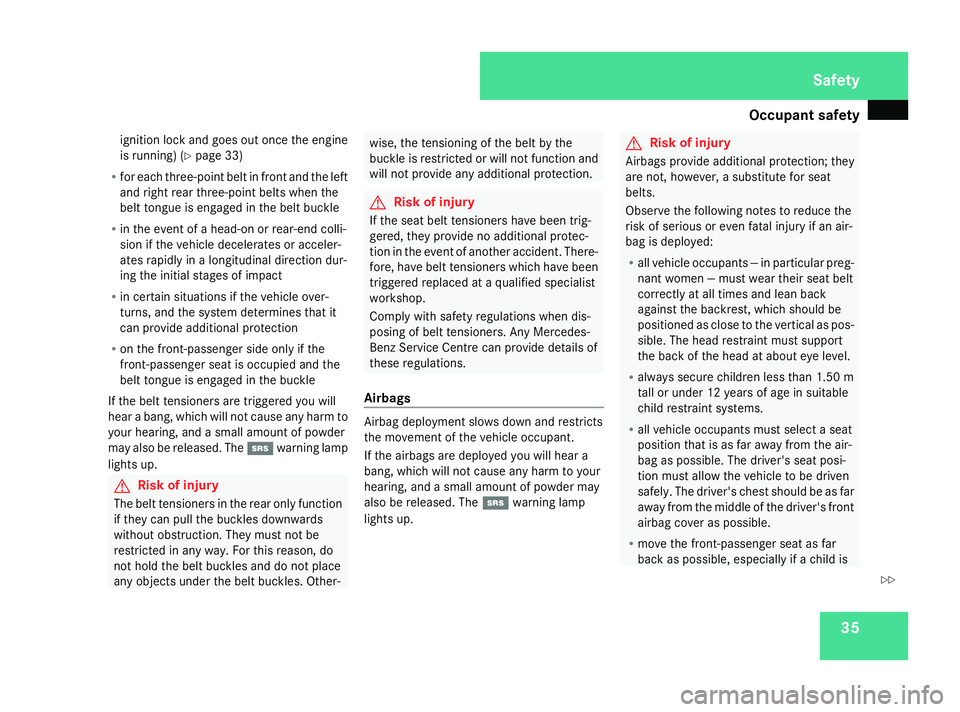
Occupant safety
35
ignition lock and goes out once the engine
is running) (Y
page 33)
R for each three-point belt in front and the left
and right rear three-point belts when the
belt tongue is engaged in the belt buckle
R in the event of a head-on or rear-end colli-
sion if the vehicle decelerates or acceler-
ates rapidly in a longitudinal direction dur-
ing the initial stages of impact
R in certain situations if the vehicle over-
turns, and the system determines that it
can provide additional protection
R on the front-passenger side only if the
front-passenger seat is occupied and the
belt tongue is engaged in the buckle
If the belt tensioners are triggered you will
hear a bang, which will not cause any harm to
your hearing, and a small amount of powder
may also be released. The 1warning lamp
lights up. G
Risk of injury
The belt tensioners in the rear only function
if they can pull the buckles downwards
without obstruction. They must not be
restricted in any way. For this reason, do
not hold the belt buckles and do not place
any objects under the belt buckles. Other- wise, the tensioning of the belt by the
buckle is restricted or will not function and
will not provide any additional protection.
G
Risk of injury
If the seat belt tensioners have been trig-
gered, they provide no additional protec-
tion in the event of another accident. There-
fore, have belt tensioners which have been
triggered replaced at a qualified specialist
workshop.
Comply with safety regulations when dis-
posing of belt tensioners. Any Mercedes-
Benz Service Centre can provide details of
these regulations.
Airbags Airbag deployment slows down and restricts
the movement of the vehicle occupant.
If the airbags are deployed you will hear a
bang, which will not cause any harm to your
hearing, and a small amount of powder may
also be released. The
1warning lamp
lights up. G
Risk of injury
Airbags provide additional protection; they
are not, however, a substitute for seat
belts.
Observe the following notes to reduce the
risk of serious or even fatal injury if an air-
bag is deployed:
R all vehicle occupants ― in particular preg-
nant women ― must wear their seat belt
correctly at all times and lean back
against the backrest, which should be
positioned as close to the vertical as pos-
sible. The head restraint must support
the back of the head at about eye level.
R always secure children less than 1.50 m
tall or under 12 years of age in suitable
child restraint systems.
R all vehicle occupants must select a seat
position that is as far away from the air-
bag as possible. The driver's seat posi-
tion must allow the vehicle to be driven
safely. The driver's chest should be as far
away from the middle of the driver's front
airbag cover as possible.
R move the front-passenger seat as far
back as possible, especially if a child is Safety
463_AKB; 1; 8, en-GB
wobuchh,
Version: 2.10.6 2008-07-17T15:19:41+02:00 - Seite 35 ZDateiname: 6515_4091_02_buchblock.pdf; preflight